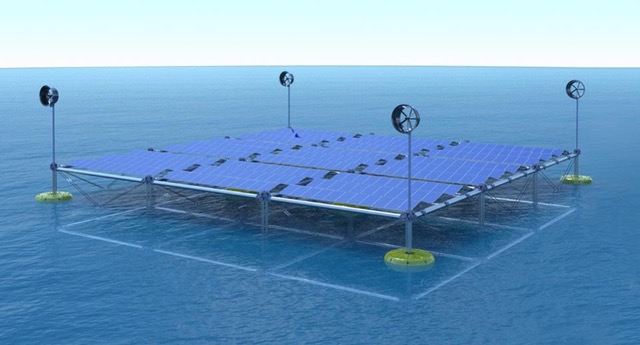Sinn Power of Gauting, Germany combines wave, wind and solar power for the “first floating ocean hybrid platform.”
The wave energy startup has received a total of $6.2 million from Schweizer Kapital and a German government ministry since its founding in 2014. According to a Forbes article, the firm hopes to offer solar panel manufacturers the chance to test PV solar arrays on a floating platform at Heraklion, off the Greek coast, as part of an off-grid energy platform.
CEO Philipp Sinn told Forbes,“The floating platform can supply renewable energy to islands across the world … and contribute to the worldwide implementation of offshore wind farms.” The modular unit can be equipped with a 20 kW solar array and up to four small 6 kWp wind turbines.
Sinn Power wants to provide “people living near coasts all over the world with access to clean electricity,” and “turn the unlimited power of ocean waves into clean and cost-efficient energy.” Sinn claims to operate fully functional prototypes at its research location in Heraklion and is “on the verge” of commercializing its technology.
Despite the potential energy held within waves and tides, the wave and tidal energy industry has been stuck in its demonstration phase for decades — unable to overcome immense technical and financial hurdles. A renewable energy investment bubble sent capital to wave companies in the aughts but recent funding has largely been restricted to government programs for demonstrations and tests.
Bankruptcies
The wave and tidal energy market is littered with bankruptcies and retreat at companies such as Aquamarine Power, Finnevera Renewables, OceanLinx, Pelamis, WaveGen and more. The companies remaining in the market such as Verdant Power, Nova Innovation or Wave Star Energy are, at best, niche power providers for oil and gas, defense, and research. Ocean Power Technologies, the only publicly-listed wave energy firm had revenue of $0.6 million and $0.5 million during the twelve months ended April 30, 2019 and 2018, respectively.
It’s feasible that wave energy equipment can be made reliable, just as the offshore drilling industry has demonstrated with its hardware — but it’s very expensive. The marine energy industry was non-competitive twenty years ago and is even less competitive now — with the advent of cheap natural gas, offshore wind and on-shore solar.
The artist’s renderings for the platform include small wind turbines and ducted wind turbines — inefficient solutions both. As for putting roof-top solar panels and electronics on the open ocean — check your warranty and IEC 61701 salt mist corrosion testing.
***
Correction: Verdant Power, contrary to our earlier reporting, is alive and well. The company received $6 million in funding in late 2018 from the U.S. Department of Energy and the New York State Energy Research and Development Authority for its Gen 5 turbine system. We apologize for the error.
This content is protected by copyright and may not be reused. If you want to cooperate with us and would like to reuse some of our content, please contact: editors@pv-magazine.com.








Solar Panels, batteries and charge controlers are already made for the sailing community. being salt water rsistant, They can provide power day and night through the batteries and inverter systems, both off grid and on grid. Wind power is already off our coasts in salt water and the platform would already be creating energy with the wind and solar power. The platform would be tethered to the ocean floor so why not have some cables additionally to heavy weights through cables to dynamos since the floating platform is already there. As the cables pass back an forth through a ratcheting and geared system to small dynamos, it would also act as a platform stabelizer much as shock absorbers do on cars and trucks reducing the rock and sway of the floating platform. This would be a great idea for getting power to disaster stricken cities near coastlines in days and not months like we have seen after huricanes.
The artist’s renderings for the platform include small wind turbines and ducted wind is wrong. The the verticle turbines would line up on the side closest the earths north pole when stationed north of the equator and the south polewhen stationed south of the equator as not to shadow any of the solar panels. The angular pitch shown on the solar array would be east to west and would need to be washed with clean water every few days to remove the salt spray build up. 22.5 degrees of pitch on the panels would add 3 hours of optimum solar production without blocking the oposing panels after the sun reaches 22.5 degrees above the horizon and the sun would be at 45 degrees to the sun facing panels when optimum power could be produced. Tracking panels would work and would require fewer panels but would require more maintenance.
Edward, you clearly know your stuff. Are you a hobbyist or is your knowledge on the professional / commercial side? I am a hobbyist and would like to share my current state to see where I can improve.
Thanks
Scott
Thank you Scott.
I am a retired IBEW inside wireman 50 year member as was my Father and Grandfather before me. I was raised in the Electrical Industry and stayed on top of things with journeyman training for anything new. Today it is Solar power with battery backup. If you are thinking of building a system of your own and want a few tips, you can E-mail me at dijeau@msn.com and I will give you my phone number so we can talk at length about the ins and outs of solar and the NEC or utility requirements.
EFD